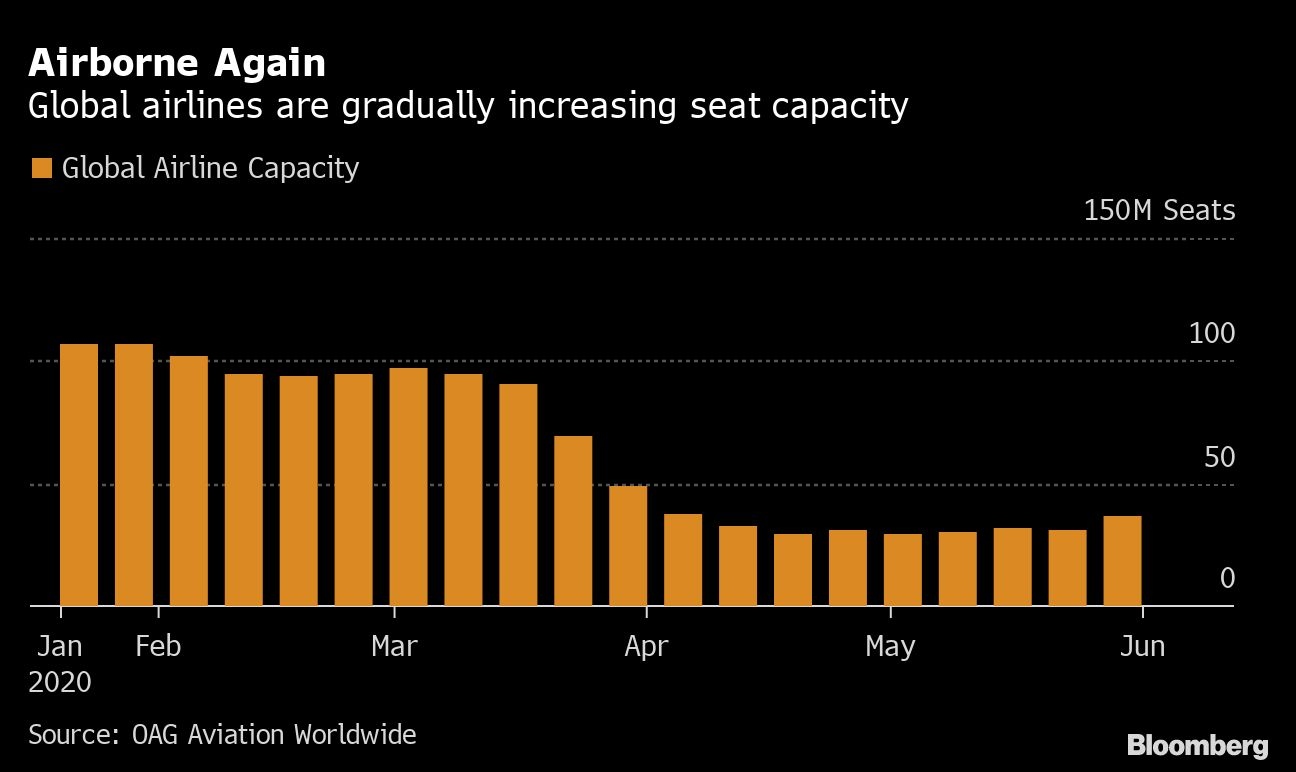Jun 3, 2020
China to allow foreign airlines back after U.S. retaliates
, Bloomberg News
U.S. Suspends Chinese Airlines' Passenger Flights
China will ease its ban on foreign airlines starting June 8, changing course a day after the Trump administration demanded the country reopen to U.S. airlines or face curbs on its own carriers flying passengers to America.
Foreign airlines excluded from an earlier pact will be able to operate one commercial passenger flight to China a week, the Civil Aviation Administration of China said. It didn’t name any countries or carriers, but the move opens up a chance for U.S. airlines to return for the first time in four months.
While the timing may have been coincidental, it appeared as a concession from China just as tensions between the superpowers intensify. The nations are locked in a tussle that began over trade but escalated to include Beijing’s handling of the coronavirus and its treatment of Hong Kong. The friction puts the phase one trade deal signed on Jan. 15 in jeopardy, along with billions of dollars in Boeing Co. aircraft sales.
“China and the U.S. should use this opportunity to restore high-level and diplomatic communications as soon as possible,” said Zhu Feng, director of the Institute of International Studies at Nanjing University. “Both sides should cut short the hawkish and emotional rhetoric, as they’re against the business interests of both.”
Flights can land in 37 Chinese cities, including Beijing, Shanghai and Wuhan, where COVID-19 first emerged. That list could change in the future, CAAC said.

If no passengers on a particular route test positive for coronavirus for three consecutive weeks, the operating airline can increase services to twice a week, CAAC said. However, a route would be suspended for a week if five passengers on the same flight tested positive. If 10 test positive, the route will be halted for four weeks.
China already allowed flights from some foreign airlines under a policy introduced in March that limited them to one trip a week and didn’t allow them to operate more services than they had scheduled on March 12.
U.S. carriers missed out because they’d suspended passenger services to and from China because of the coronavirus pandemic, which devastated the global aviation industry as countries imposed travel restrictions and demand disappeared.
Washington’s order on Wednesday would stop passenger services by Chinese airlines starting June 16, though President Donald Trump could impose the ban sooner if he chooses. The order stops short of an outright ban, allowing Chinese carriers to operate one flight to the U.S. for each flight that China grants to American carriers.
By Thursday afternoon, flights between China and the U.S. was one of the most popular topics on China’s Twitter-like site Weibo, as users debated whether CAAC’s announcement was yielding to Washington’s threats or was a sign of Beijing taking back control and incentivizing airlines to control virus risks.
The U.S. Department of Transportation said last month that China violated a bilateral agreement because it didn’t respond to requests by Delta Air Lines Inc. and United Airlines Holdings Inc. to resume flights. Four Chinese carriers have maintained flights to and from U.S. airports.
“The Chinese government’s failure to approve their requests is a violation of our Air Transport Agreement,” the DOT said Wednesday. It also accused China of being “unable to communicate definitively” about when it will allow U.S. carriers to resume flights.
At a briefing in Beijing on Thursday afternoon, foreign ministry spokesman Zhao Lijian said China has been in close communication with the DOT, and the two sides made progress. China hoped the U.S. wouldn’t “create obstacles” to resolving the issue, he said.
A U.S. ban on flights wouldn’t hurt Air China Ltd. too badly given its limited exposure to the market, Bloomberg Intelligence analyst James Te said, noting that only 6.5 per cent of the carrier’s 2019 revenue came from North American routes.
China Eastern Airlines Corp. and China Southern Airlines Co. also get the bulk of their revenue from the domestic market, and even more so now that international routes are restricted.
The “Big Three” Chinese carriers all rebounded from losses of about two per cent Thursday morning to close higher in Hong Kong, led by China Eastern with a 1.8 per cent gain.
In early January, there were about 325 scheduled flights a week between China and the U.S., but that slid to only 20 a week by four Chinese carriers by mid-February, according to the DOT.
Delta is seeking to restart flights to Shanghai on June 11 from Detroit and Seattle, while United also plans to resume three routes this month, pending approval. American Airlines Inc. plans to resume flights to China in October.
U.S. airline shares rose Wednesday amid a broad market rally and signs that travel demand is starting to rebound. A Standard & Poor’s index of major carriers rose 7.6 per cent to the highest since March 27, with United leading the gains with a 13 per cent jump.
Boeing also climbed 13 per cent after the International Air Transport Association indicated a recovery was underway for global airlines. Still, the tension between the U.S. and China adds to the risk and uncertainty for Boeing’s 737 Max and 787 Dreamliner, two aircraft that are critical to its recovery from the worst downturn in aviation history.
While China was the largest customer of the 737 jetliner before Trump was elected, its airlines last ordered the Max in September 2016, according to Boeing’s website. The country hasn’t bought any planes from the Chicago-based manufacturer in more than two years.
Airlines for America, a trade group that represents large U.S. carriers, applauded Wednesday’s announcement on the restrictions for Chinese carriers.
“We believe DOT’s order will ensure fair and equal opportunity for passenger airlines with respect to service to and from China,” it said in a statement.
--With assistance from Alan Levin, Harry Suhartono and Colum Murphy.


